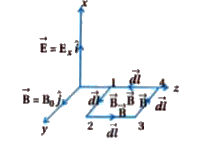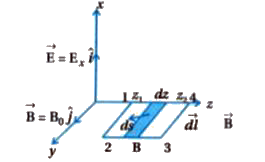InterviewSolution
Saved Bookmarks
| 1. |
A plane EM wave travelling in vacuum along z - direction is given by vec(E )=E_(0)sin (kz - omega t)hat(i)andvec(B)=B_(0)sin(kz - omega t)hat(j).By using similar process and the equation int vec(B).vec(d)l = mu_(0)I+ in_(0)(d phi_(E ))/(dt), prove that c=(1)/(sqrt(mu_(0)in_(0))) |
Answer» Solution :As shown in FIGURE square loop 1234 is in yz - plane. `oint VEC(B).vec(d)l=int_(1)^(2)vec(B).vec(d)l+int_(2)^(3)vec(B).vec(d)l+ int_(3)^(4)vec(B).vec(d)l+int_(4)^(1)vec(B).vec(d)l` `= int_(1)^(2) B dl cos 0^(@)+int_(2)^(3) B dl cos 90^(@)+int_(3)^(4)B dl cos 180^(@)+ int_(4)^(1)B dl cos 90^(@)` `= B_(0)h[sin(kz_(1)-omega t)-sin (kz_(2)-omega t)] "" [because " taking " dl = h] ""`...(3) Now to find `phi_(0)=int vec(E ).vec(d)s` consider square loop 1234 which is made up of no. of small section of area DS = hdz.  `phi_(E )=int vec(E ).vec(d)s = int Eds cos 0^(@) = int Eds "" [because cos 0^(@)=1]` `= int_(z_(1))^(z_(2))E_(0)sin (kz_(1)-omega t)hdz` `=-(E_(0)h)/(k)[cos (kz_(2)-omega t)-cos (kz_(1)-omega t)]` `therefore (d phi_(E ))/(dt)=(E_(0)h omega)/(k)[sin (kz_(2)-omega t)-sin (kz_(1)-omega t)] ""` ...(4) From Ampere law, `oint B dl = mu_(0)(I_(c )+in_(0)(d phi_(E ))/(dt))` where `I_(c )` is conduction current for vacuum `I_(c )= 0` HENCE,`oint B dl=(mu_(0)in (d phi_(E ))/(dt))` From equation (3) and (4), `B_(0)h[sin (kz_(1)-omega t)-sin (kz_(2)-omega t)]` `= mu_(0)mu_(0)(E_(0)h omega)/(k)[sin (kz_(1)-omega t)-sin (kz_(2)-omega)]` `therefore B_(0) = (mu_(0)in_(0)E_(0)omega)/(k)` `therefore (1)/(mu_(0)in_(0))=(E_(0)omega)/(B_(0)k)` `therefore (1)/(mu_(0)in_(0))= c xx (ck)/(k)[because (E_(0))/(B_(0))=c " and " omega = ck]` `therefore (1)/(mu_(0)in_(0))=c^(2)` `therefore c=(1)/(sqrt(mu_(0)in_(0)))` |
|